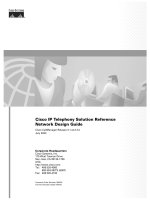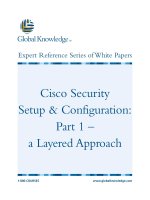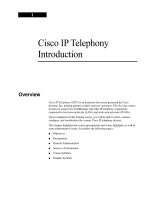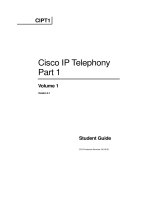Tài liệu Cisco Design Essentials: Cisco IP Telephony- Enterprise Voice Over Data Design Test pdf
Bạn đang xem bản rút gọn của tài liệu. Xem và tải ngay bản đầy đủ của tài liệu tại đây (326.45 KB, 12 trang )
Cisco Design Essentials: Cisco IP TelephonyEnterprise Voice Over Data Design Test
1)
Cisco supports and is certified with the Lucent Octel 250 and 350 for CallManager 2.x.
a. True
b. False
2) How many bytes of padding would be in the payload of an ATM AAL5 cell containing 20 ms of G.729
voice?
a. 20
b. 28
c. 44
d. 48
3) Consider this scenario. You have two branch offices using IP telephony with CallManager 2.4. To handle
admissions control between the two offices over a WAN, which of the following solutions will work?
•
•
Solution A: Use a central CallManager (perhaps redundant CallManagers) with each office being a
separate region. Intra-region calls can be G.711, but inter-region calls can be G.729 (unless to voice mail).
Limit WAN bandwidth at each egress point and block calls that will exceed that level.
Solution B: Put a CallManager in each location and network them together using H.323 (running on a
Cisco IOS gatekeeper). You can then use the zone bandwidth feature to limit the number of calls and force
overflow to the Pub lic Switched Telephone Network (PSTN).
a. Solution A
b. Solution B
c. Either A or B
d. Neither A nor B
4) If the maximum acceptable delay that a low-speed link may add to your delay budget is 20 ms and the link
speed is 64 kbps, then the maximum fragment size should be ____ bytes.
a. 80
b. 140
c. 160
d. 320
5)
VAD is a mechanism for reducing bandwidth requirements when transporting:
a. Voice over IP
b. Voice over Frame Relay
c. Voice over ATM
d. A, B, and C
e. A and B
f. B and C
g. A and C
6)
Every minute of messages takes _________ of space in the uOne message store.
a. 250 kb
b. 750 kb
c. 1 Mb
d. 1.2 Mb
7)
The CallManager database uses _________ to tie an actual IP Phone to a telephone number.
a. Media Access Control (MAC) address
b. Directory Number
c. Line Appearance Number
d. IP Address
8) The _____________ low bit-rate coder requires less CPU power, while maintaining high voice quality, thus
enabling support for two voice calls on a single DSP.
a. G.711
b. G.729
c. G.729a
d. G.723
9) Consider this scenario. You want to connect your IP Telephony network to the central office switch using E1
(or T1 PRI). Which of the following choices is an appropriate gateway selection?
a. the DT-24+ (or DE-30+) IP Telephony gateway
b. AS5300 Cisco IOS Gateway using 12.05(T)
c. MC3810 Cisco IOS Gateway using 12.05(T)
d. A, B, and C
e. A and B
f. B and C
g. A and C
10)
Which of the following is not a benefit of Simple Gateway Control Protocol (SGCP)?
a. Emphasis on a simple and reliable protocol
b. End points can be mass produced cheaply
c. Smaller set of instructions at the client end mean lower CPU and memory requirements
d. Large set of instructions provide intelligence in endpoint
11) For capacity planning purposes, plan for G.711 traffic to require ___ through a Cisco router (uncompressed
RTP header and excluding link- layer header).
a. 80 kbps
b. 24 kbps
c. 17 kbps
d. 74.6 kbps
12)
Cisco handles lost packets in the playout buffer by:
a. Repeating the previous packet
b. Using a concealment strategy based on context
c. Inserting pre-determined noise
13)
The Frame Relay Forum standard for encapsulating voice over a Frame Relay network is:
a. FRF.5
b. FRF.9
c. FRF.11
d. FRF.12
14) CallManager 2.x puts call detail records (CDRs) in Access or an OBDC database that is readable by most
billing packages, but does not provide direct billing itself.
a. True
b. False
15) Leaving or retrieving a message under the uOne architecture involves which of the following protocols:
a. SMTP
b. Lightweight Directory Access Protocol (LDAP)
c. Cisco Skinny
d. All the above
e. None of the above
16) Which of these statements are true about the IP WAN with centralized call processing using CallManager
2.4?
a. All local gateway access codes must be different
b. Conferencing and voice mail must use G.711
c. Phones are out of service if the WAN goes down unless there is dial backup
d. All the above
e. A and B only
17) Cisco can translate protocols such as ISDN PRI and QSIG, but it can only transport protocols such as DCS+
and MCDN.
a. True
b. False
18) Cisco-switched VoFR protocol includes forwarding of the called telephone number and supports tandem
switching of the call over multiple Frame Relay permanent virtual circuit (PVC) hops.
a. True
b. False
19) ____________________ is a technique for breaking up and re-assembling large data frames to avoid
"freeze-out" of delay-sensitive traffic in the network.
a. Traffic shaping
b. Committed access rate (CAR)
c. Fragmentation and interleaving
d. RSVP
20)
Voice mail applications:
a. Are critical to the enterprise
b. Are proprietary in legacy systems
c. Have to be replaced by uOne in the Architecture for Voice, Video and Integrated Data
(AVVID) IP Telephony solution
d. A and B
e. B and C
f. A and C
21)
Which of the following elements requires minimizing to provide voice quality in packet or cell networks?
a. Loss
b. Delay/Delay Variation
c. Echo
d. A, B, and C
e. A and B
f. B and C
g. A and C
22)
It is generally recommended that IP Phones be supplied static addressing.
a. True
b. False
23) Which of the following are true statements about CCS?
a. CCS is not necessarily ISDN
b. Instead of robbed-bit signaling, a DS0 is reserved for signaling
c. Signaling is handled on TS 16 for E1
d. A, B, and C
e. A and B
f. B and C
g. A and C
24) If you install the conferencing software on a separate NT server, the maximum number of participants on a
conference call is _____.
a. 18
b. 20
c. 33
d. 49
25) Consider this scenario. You want to emulate a fractional T1 or E1 for transport across an ATM network
without consuming the full 1.54 (or 2.04) Mbps by only carrying the emulated DS0 channels and leaving the
unused bandwidth for other applications. Which service would you use?
a. T1/E1 circuit emulation services (CES) unstructured
b. T1/E1 CES structured
c. FRF.12
d. MLPPP
26)
Using a single PVC for voice and data, instead of separate PVCs for each:
a. Is more economical
b. Provides higher quality voice
c. Requires a star topology
d. A, B, and C
e. A and B
f. B and C
g. A and C
27)
Which transport technique is preferred to carry Lucent's CMS?
a. Digital cross connect
b. Frame forwarding
c. D-channel ATM CES
d. STUN
28) In ATM the AAL Cell Tax refers to the fact that the number of bytes in the AAL varies from 0 to 5 bytes
and that these bytes are subtracted from the size of the remaining 48 bytes available for payload (since the header
size is constant), thus reducing payload maximum to as low as 44 bytes.
a. True
b. False
29)
With redundant centralized CallManagers, failover takes about _____.
a. 30 seconds
b. 90 seconds
c. 3 minutes
d. 10 minutes
30) In traffic shaping, when shaping to a lower-speed link and the ratio of the line rate to the CIR is high (for
example, a T1 shaped to 64 kbps), you need to set the committed burst (Bc):
a. Higher
b. Lower
c. It doesn't make any difference.
31)
System assurance is a key part of the planning stage of design methodology, because:
a. It ensures that a network foundation exists on which voice applications can be built
b. It ensures that an existing network can handle voice traffic reliably
c. It provides the necessary information to perform capacity planning
d. A, B, and C
e. A and B
f. B and C
g. A and C
32)
Which of the following statements are true about Voice over Frame Relay services?
a. Primary payload types may include voice, fax, or data
b. Signaled payload types may include dialed digits, silence information, or CAS ABCD
bits
c. Manageme nt payload types include faults and performance measurements
d. A and B
e. B and C
f. A and C
g. A, B and C
33)
Which of the following results is NOT a benefit of IP Telephony:
a. Lower total cost of ownership
b. Support for emerging applications like virtual call centers
c. Efficiency of a proprietary architecture
d. More effective infrastructure investment
34)
Calculate the bandwidth for a G.729 call using a 20- ms sample size with AAL5 configured.
a. 20 kbps per call
b. 21.2 kbps per call
c. 28 kbps per call
d. 53 kbps per call
e. None of the above
35) You are planning for an IP Telephony deployment including the deployment of CallManager in a branch
office. Which of these factors should you consider as you assess the customer's existing branch office voice and
data networks?
a. Are firewalls present on any LAN where Voice over IP traffic would travel?
b. Are the available ports switched or on hubs?
c. Does the customer require an MWI for voice mail messages?
d. What protocol or signaling is used between handset and PBX for the existing PBX?
e. A, B, C, and D
f. A and B
g. A, B and C
h. A and C
36) In designs involving tie- line replacement and toll bypass solutions, voice mail considerations will not impact
your design since voice mail will typically be carried via the PSTN to the PBX.
a. True
b. False
37) Real-time Transport Protocol (RTP) is an industry standard for transporting:
a. Voice over IP
b. Voice over Frame Relay
c. Voice over ATM
d. A, B, and C
e. A and B
f. B and C
g. A and C
38)
The following issues must be considered when calculating WAN bandwidth requirements:
a. Need for supplementary services
b. Ability to roll to voice mail
c. Requirement for conferencing support
d. Call transfers across the WAN
e. All of the above
f. None of the above
39) Cisco's uOne is a standards-based messaging application that manages message playback, message delivery,
and the message creation process in CallManager 2.4 deployments.
a. True
b. False
40) To complete a traffic analysis and thereby plan for sufficient bandwidth on the converged data network, it is
mandatory that you conduct a detailed traffic engineering study and calculate trunk requirements from rate,
blocking and Erlang-B tables.
a. True
b. False
41)
Which of the following is a variable source of delay in voice networks:
a. Queuing delay
b. Propagation delay
c. Serialization delay
d. Coder processing delay
42)
Which of the following are you least likely to encounter providing PBX trunk signaling?
a. ISDN PRI D channel
b. DASS#2
c. FXS loop start
d. a proprietary PBX-to-PBX protocol such as Lucent's DCS+
43) H.225 registration, admission, and status (RAS) channels are unreliable and subject to timeouts and retry
counts.
a. True
b. False
44) CallManager 3.0 will support MGCP, which allows for Cisco IOS gateway and CallManager integration
without an MTP.
a. True
b. False
45) Which of the following statements is true for an H.323 Gateway?
a. Handles call setup and clearing on both sides
b. Can translate between transmission formats for an IP ne twork and the PSTN
c. Is optional in H.323 networks
d. All of the above
e. None of the above
46) In implementing Voice over Data networks, in all likelihood you will be able to use the legacy dial plan
without any changes.
a. True
b. False
47)
The ITU specifies the threshold for high quality vo ice as an end-to-end delay of:
a. 100 ms
b. 150 ms
c. 200 ms
d. 250 ms
48) Which of the following statements are true about Lucent protocols?
a. NFAS allows a single D channel to control up to 300 voice channels
b. EPN requires unstructured T1s to extend remote cabinets over fiber connections
c. DCS+ can be frame- forwarded over a Frame Relay network on a Cisco 3810
d. A, B, and C
e. A and B
f. B and C
g. A and C
49)
Cisco IP Telephony dial plan terminology uses the constructs of a route plan and _______.
a. Route points
b. Route groups
c. Route filters
d. Device end points
50)
Which of the following statements are true about quality of service (QoS) using an ATM network.
a. End-to-end QoS is available in the ATM network by contracting for the services needed
to insure the voice quality required
b. Priority queuing and traffic shaping may still be needed in the end systems
c. Both
d. Neither
Grade









